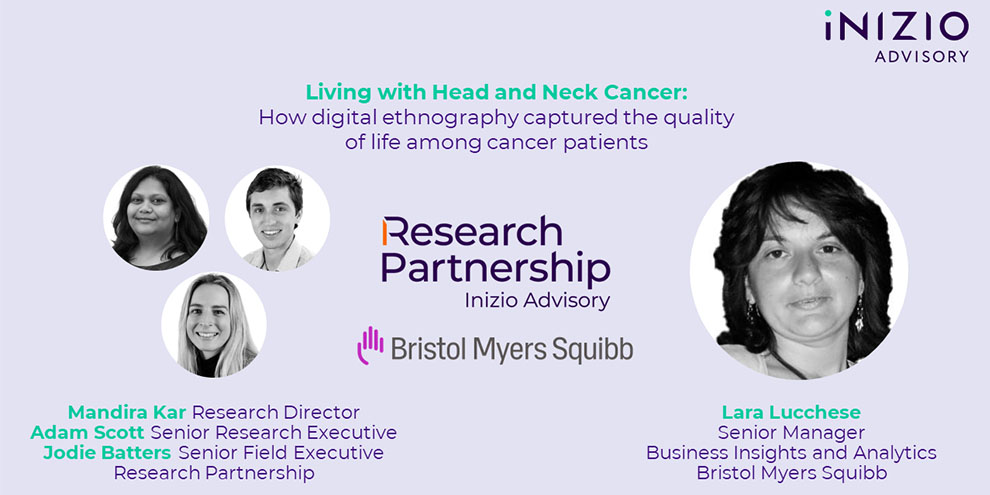Q&A with Marketing Research and Insight Excellence Award winner Research Partnership
Editor’s note: Research Partnership and Bristol Myers Squibb are the winners of the 2022 Health Care/Pharmaceutical Research Project Award, a category in the Marketing Research and Insight Excellence Awards. This award is for a project that took an innovative approach to health care or pharmaceutical marketing research that had the potential for long-term influence. To find out more about the awards click here.
There is a growing need to understand what really matters to head and neck cancer patients and what improvements can be made in their care and everyday lives. Using innovative digital ethnographic techniques, along with techniques grounded in cognitive psychology, anthropology and psychotherapy, Research Partnership was able to go deeper and explore beyond the obvious.
Findings from this study are impacting patients in real ways, from policy changes to creating awareness and supporting patients and their caregivers. I chatted with Research Partnership to learn more about the study.
What were the driving factors in conducting this project?
Since the 1990s, the incidence rate of head and neck cancer has increased, with almost 12,000 new cases diagnosed annually in the U.K. But, despite this prevalence, head and neck cancer does not receive the same public awareness or attention as the more common cancers. Moreover, there is a lack of understanding of the consequences and impact in the aftermath of this cancer - especially when it comes to the quality of life challenges faced by patients post-treatment.
Our goal at Bristol Myers Squibb (BMS) is to use the insights from this study to drive real change for patients by developing emotional and engaging case studies to support a policy whitepaper and create awareness among England’s National Health Services’ (NHS) policy makers, health care practitioners and the British media.
To explore quality of life, we used an ethnographic approach. Ethnography is an empathetic and immersive approach that brings alive unfiltered experiences from patients' daily lives in their environment and empowers them to share their story from their lens and the lens of their family members. The approach captured thick descriptions of what patients have endured, the impact cancer had on every aspect of their life, like their bodies, their psyche, work life, their relationships and, eventually, their identity.
What is being done for patients as a result of this study?
Since the completion of the study, BMS has been working toward driving initiatives to affect real change for patients. A great example of that is the BMS virtual bust initiative which will bring to life the findings from our research. The interactive 3D model includes patient testimonials from this digital ethnography study which highlights the difficulties they have encountered both physically, such as problems communicating, eating and drinking, and also the psychosocial impacts of treatment, including on mental health, financial security and family life. The bust will be used to increase awareness of the quality of life implications for head and neck cancer patients and highlight how this is impacted by different treatment pathways. With this initiative, we are creating awareness among policymakers, parliamentarians and system leads.
What were some of the methods you used for this project?
Cancer treatment and recovery is a long and complex journey that takes years, and an extended engagement is essential. We conducted 90-minute video interviews followed by 10 days of video dairies. To aid the recall of past events, we used Timehop, a technique that relies on images to access past experiences/moments.
Unpacking years of trauma endured is a vulnerable experience for patients. We used cognitive journaling, a process grounded in cognitive psychology, to help patients reflect on their journey gradually, and it was a cathartic experience for patients.
Increasingly, patients are chronicling their experiences on social media and speaking a different narrative from offline. We looked at both the offline and online lives of patients.
To explore and understand deep-rooted emotions, aspirations and beliefs, we focussed on objects and experiences of high emotional significance, which is more effective than direct questioning.
Care rituals are deeply integrated into patients' lives and help them cope and heal. Observation of care rituals explored the dichotomy between what patients say vs. what they do.
Last but not the least, we used the lens of a social theory to make meaning of the insights and decipher the root causes of patients' beliefs and behavior
